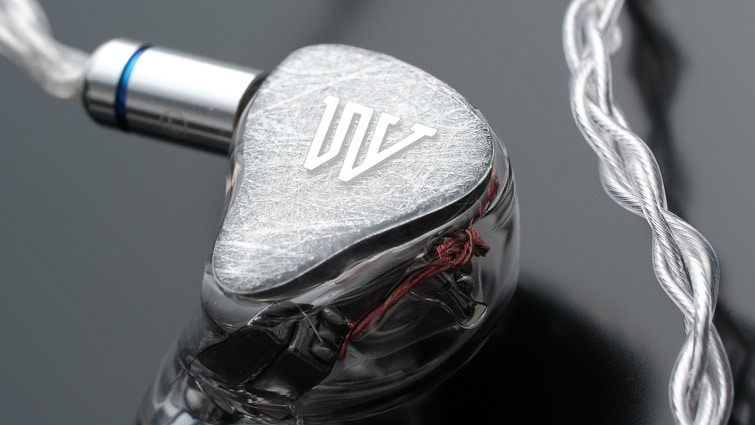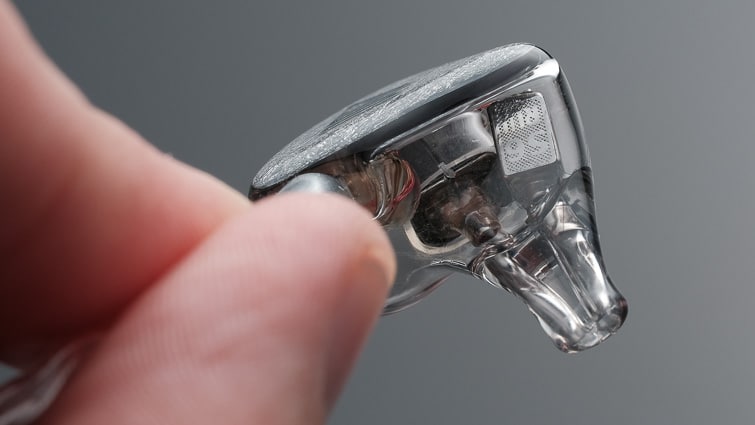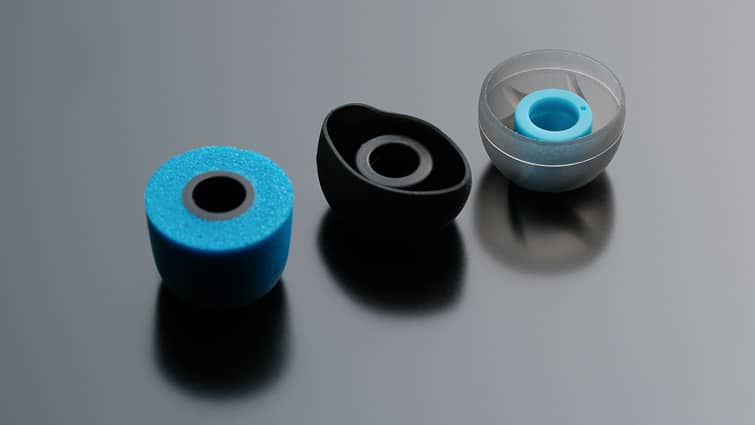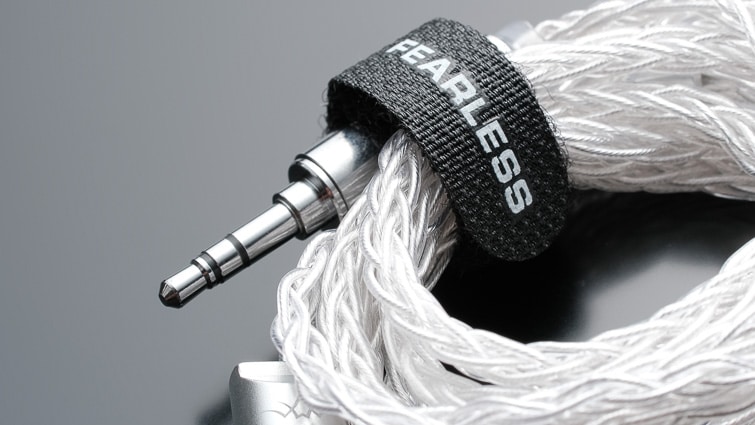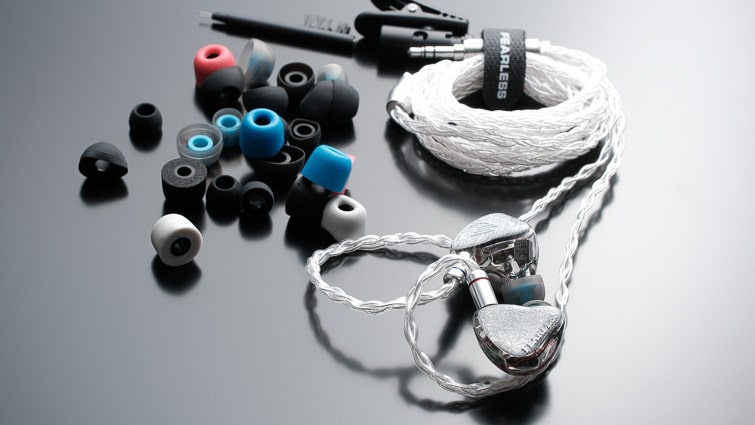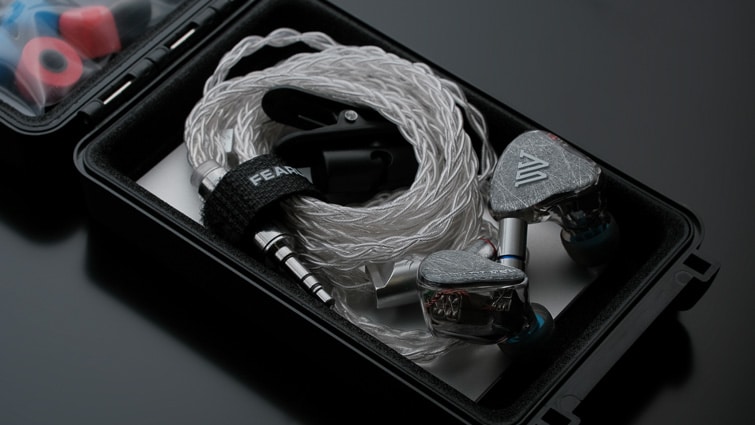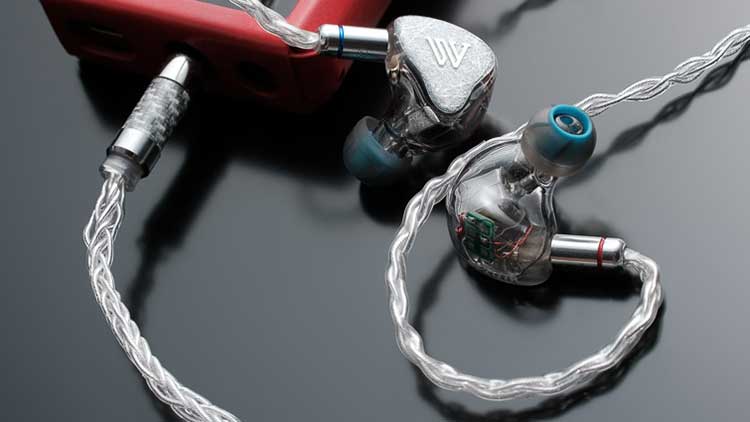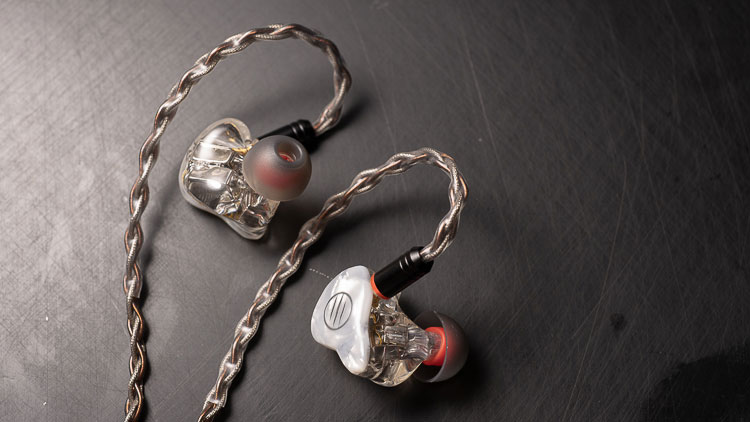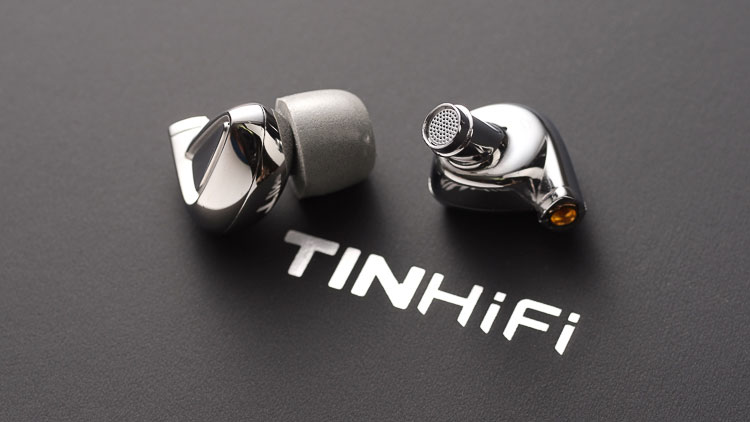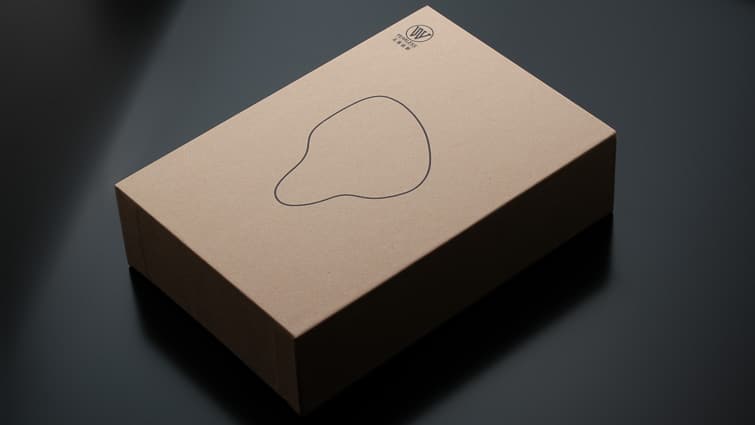The Fearless Audio S6 Rui is a 6 balanced armature driver universal in-ear monitor with a 3-way crossover. It is priced at $479.
Disclaimer: The Fearless Audio S6 Rui sent to us is a sample in exchange for our honest opinion. We thank the team at Linsoul & Fearless Audio for giving us this opportunity.
To read more about Linsoul products we featured on Headfonics click here. Note, this review follows our new scoring guidelines for 2020 which you can read up on here.
Wanna know what’s braver and more courageous than removing a headphone jack? Not naming your audio company something pretentious. Like, if it were up to me, I’d call my company Dude Bro Audio or something like that. The company that made the S6 went for Fearless Audio.
If only they had stopped there- or added a ’No’ in front. If they had done that, the pretentious Rui would have been steamrolled. And, it would have been epic. Totally. So, both pretentious and not, and expensive and strangely branded, S6 Rui sort of hits it in the solar-plexus with the double fist of sophomoric marketing and amazing engineering.
Build Quality
The S6 Rui’s striking exterior glints like few earphones out there. Fine lines in mature shades make it look great under the lights. It is nice and shiny and crisscrossed and striated like the thing up there they say is a moon.
Internally, its wiring isn’t as clean as the BGVP DM7, but where the DM7 shows a more generic soma, the S6 brands every driver within its body. As far as I can tell, the internal story is spelled out: Fearless (x4), and S6 Rui (x2). I’ve not seen its like outside of what you find under the bonnet of an upmarket car.
Shell
Unlike a few mid to hi-end custom-cum-universals on the market, S6 Rui’s shell is all air inside. A bit of resin glue to hold the drivers and unbranded crossover in place. The crossover is pasted into the upper back of the earphone case and the bundled driver 4-pack (labeled Fearless) almost floats in the case. Eery.
You’ll notice that S6’s sound tube is all smooth out to the tip. Earphone manufacturers: flanges are good. Sure, ear tips are easier to insert when you’ve circumcised your tubes, but clipped tips also means that earpieces fall off easier. I’ve tried a number of tips and every one treads the uncomfortable line of slipping or almost slipping off the sound tube and getting lodged in the ear.
Connectors
The 2-pin plug also goes in and comes back out with too little effort. That may protect the joint, but it also means that unexpected movements may also dislodge the cables. Both the loose joint and circumcised flange are odd oversights in an earphone that costs as much as the S6 does. It also somewhat cheapens both the S6’s and Fearless’s image.
I reckon Fearless put a lot of effort into branding Rui’s drivers. I wish they put as much effort into making the earphone easy to wear and more robust.
Comfort & Fit
Rui fits like all custom-cum-universal earphones. The good is that its insertion angle is ergonomic and blasts past most full universal-fit earphones. The bad news is that while light, it is tubby; I reckon that Asian girls, in particular, will find it harder to stuff in their ears. Because it is so light, it never feels that solid in the ear. And, of course, its MMCX connectors aren’t all that solid.
Tips
The awesome news is that its ear tips are nice and comfy. They sport low-profile equatorial ridges; and heck, you get loads and loads of these suckers to try out, including foamies and spiral-core silicons.
Cable
Because the cable lacks memory wire, it is decent for glasses wearers. Because it is three-strand per channel, it’s got hella audiophile cred. Its y-split is a bit fat, but its cinch stays put at any height adjustment, and its carbon fiber adorned plug is nice and familiar.
I wish it weren’t a straight plug, but I’ve begun to come to terms with the fact that as players get larger and larger, the reasons to install L-shaped plugs for safe pocket-use dwindle. This ain’t the early 2010s anymore. It also ain’t MD days no more.
Accessories
Packed snug in a super generic (especially for the price) cardboard box, S6 Rui comes with the following ear tips and other stuff:
- Spiral-core silicon tips: x3 pair
- Foamie tips: x4 pair
- Generic black tips: x6 pair
- Fit-Ear style rotatable shirt clip: x1
- Wax loop / brush: x1
- Velcro cable tie: x1
- Hard-sided, snapping plastic carry case: x1
All of the above comes packed int a single thick-walled zip-bag whose opening flanges are so damn shallow that I wanted pliers to prise them open. (Remember, I’m a general metrosexual with slim hands and fingers; anyone with meaty or large or just worker hands won’t be able to get this bag open without scissors.)
The case is lined with a thin, but a functionally protective layer of foam, and on the opposite side is a metal guarantee card. Apparently my unit was made by a person called ‘Yoyo’- which explains a lot. The lot barely fits into a cheap snapping plastic box too long to fit in a pocket and too cramped to fit everything comfortably in.
It’s cool that there is so much packed in there, but, again, for the S6’s price, it all seems too close to a garage product in the application, feel, layout, and quality.
Sound Impressions
Tonality and Presentation
Every misgiving above is overshadowed by the S6’s beautiful, detailed, but ultimately musical rendering of my favorite tunes. Largely it spits tunes out flat, with a wide-open high-frequency range and warm bass and rich midrange. Sonorous ring underscores everything, giving it one of my favorite signatures among balanced armature earphones I’ve reviewed here.
Gosh, it is neither too hot nor too cold, and it mates perfectly with everything from Depeche Mode to Pink Floyd and is speedy in attack and decay to keep up with ye olde 2000-era trance. Gosh.
Okay, so, because it’s not got the deepest or hardest hitting of basses, it does respectfully ‘duff-duff’ (although below the bass-head radar) to American hip hop. Are those lows quality lows? Heck yes, they are.
Staging
From time to time I go all lyrical about stereo vignettes. When done right, with slow rolls off, and good texture detail, gosh, they really bring soft, natural focus to the center. Well – and I’m sure you can tell where I’m going here -, Rui has one of the most beautiful stereo vignettes I’ve heard in a balanced armature earphone. Had its literature said that inside it hid a Planar driver, I’d be like: ‘sounds about right’. But it doesn’t.
Remember how I went all bubbly about the DM7? The S6 does the same to me, but to an extremer degree.
Anyway, the stage goes pretty far to the left and right- as far as the shoulders say -, but its beauty is that I can’t really tell if it goes beyond that. The vignettes are so gentle that my mind can’t wrap it all together. Does it get farther than that? Does it stop before that? I have no idea. The thing is that it doesn’t matter.
The fades are super sweet along the X-axis fringes. The Y is similarly sweet and long-fading. Both the X and Y are firm in the middle and slowly fade into the air from there, and spread excellently far and wide until then. The Z takes one step forward, and as such, isn’t super deep, but again, the fade going into it and up to its final stop and is wholly beyond reproach.
Bass
Would you guess? Not only does S6 Rui fade nicely to the sides, but it also fades into high bass and medium bass from the real lows. It is excellent. As are recovery speed, space, and texture. Okay, the texture isn’t Schneider APO Macro Digitar 120mm F/5,6 sharp, but downstrokes in all string and percussion instruments leave palpable twang and body with every thwack.
And the bass stereo image is wide, again, tempered by a lovely vignette to the sides and along the Y-axis. Because S6 bass never throbs against hard walls, it’s like listening to music in a large anechoic chamber – with a few echoic partitions within peripheral eyeshot. Here and there you catch a bit of their reverb, but only just, and exactly when you’d want to. Bass doesn’t jump up in pressure above mids at the ear, but at the measurement bot, it’s about a step above.
At this point, I should mention that S6 Rui doesn’t pass the Marcus Schulz Mainstage test. Sure, mid and high bass throb, but not during those sub-bass intro seconds. There, S6 is quiet and neutral, waiting, waiting, and then about 8 seconds in, its energy builds.
Lows are round-headed, free of bloom, and beautifully fade into the lower mids. Low-frequency basic frequency response is just north of neutral, but with a longish downward decay, meaning it has sub-bass information, just not a lot of it against the ear’s acoustics.
All of that is why S6 Rui nails trance. It’s got good enough texture to keep the focus on bass, but the natural fades into mids and along the stereo axis soften up somewhat harsh edges.
Mids & Highs
Absolute high-frequency edges are soft – vignetted if you will -, but the signal reaches the fringes with plenty of verve. S6 is sibilance-free and ready for music with loads of high-frequency razzle.
If piercing highs are a thing you really, really, try to avoid, S6 has you covered. It’s not covered quite in the texture-heavy MDR-EX1000 with foamies way is covered, but it’s not far off. And it’s not got it covered the way a Tin HiFi P1 has it covered and smoothed over. But again, it’s not far off. Rui’s mid and low ranges don’t dredge up as much texture to accentuate a fast fade. Rather, the overall round-edged bass and mids feed into a lazily faded high range where, along the X-axis specifically, there is plenty of space and separation between instruments.
The overall tone within the midrange is warm-ish, with good to great rear-action decays, and massive X-axis reach. How many times did I look behind me to make sure there wasn’t a maraca band down the street from me playing in time to ATB’s 9 PM (Till I Come)? The answer is more than once.
If you want more audiophile-like examples, vignettes and natural fades really sync Pink Floyd’s Marooned to anechoic perfection. Nothing, ever, is out of place. No tall poppies to cut down. No nails poking here or there to hammer in.
Vocals
Male vocals are loaded up well with moving pathos. This is probably because of the great transitions between high bass and low mids. Female vocals are much the same, but higher. Rui nails both. It also carves from the vignette a brighter niche that focuses in on your favorite singer. Again, this is probably due to the S6’s wide, vignetted stereo and also partially due to its ability to really throw signals wide. In between all that is a bright center.
The mild grade low pass filter that softens highs is done better in no earphone I’ve heard at any price. Wow. Gosh. Cool.
Matchability
Oh my, is the S6 sensitive. Remember how I complained about how much Cupid hissed with my favorite Aiwa MD recorders? Well, S6 is more sensitive and hisses at just about every turn.
Sure, a good iPhone or DAP won’t hiss much with it, but anything less will, sometimes annoyingly so. MD users: unless you have certain Sharp Auvi units, you’re going to get a LOT of hiss from the S6. Even if you have an Auvi, you’ll have to deal with the unfortunate problem innate to most Sharp units: poor current, and attendant artifacts in frequency response and stereo separation due to massive impedance swings.
That is: S6 is fully ready for high-end audio players that don’t hiss much. The only contemporary ones I’d not pair with Rui are the Astell & Kern SPM1000, FiiO M6, and the AK70ii, each of which hisses like something from the late 90s.
Because the S6 is so sensitive, it will be tough to use with home gear unless that gear boasts really high-quality attenuators with loads of low volume headroom, not to mention low line noise.
In addition to being so sensitive, S6 Rui isolates well, meaning you won’t need much volume on any device. You will, however, need headroom at lower volumes.
Select comparisons
BGVP DM7
I loved the DM7’s brilliant blend of brightness and smoothness. It totally bettered the DM6. Well, the S6 betters the DM7 like the DM7 bettered the DM6. It has a richer, if darker stereo vignette, textured vocals, and solid, neutral bass. It’s also got a planar thing going on up top, which is a nice departure.
The price difference between the two is significant, and the DM7 is built better and it handles like a higher-end earphone. It’s win-win, lose-lose between the two. Sound-wise I prefer the S6.
Tin HiFi P1
Strange that I’d bring in the P1 to compare to an all-armature earphone. But why not? S6 Rui is the closest armature earphone I’ve heard to a bright-tipped planar design
. For those not totally sold on the dark and rich and too-neutral planar sound, S6 injects a nice but gentle rise in bass and a bit of sparkle in the highs and upper mids that typical planar designs lack. It’s also got a better sense of instrument separation but isn’t quite as able to cast a forward-stepping Z-axis.
Our Verdict
If it weren’t for the S6 Rui’s so-so finish and meh attention to detail in branding as well as basic utilitarian body functions, I’d be totally ecstatic about it. As it is, it functions okay, comes with a lot of accessories in a so-so package, but looks and acts like a much cheaper earphone.
The strikes against it are big. But it sounds so damn good that I’m almost willing to remove the strikes. The problem is that an earphone is something intimate. And for me at least, how the brand treats its designs and how it defines that design through utility is something that leaves a large impression.
Rui sounds better than most earphones I’ve heard in years. I vastly prefer it to the DM6 and DM7. Gosh, it may be my favorite sounding balanced armature earphone of all time. But all that great sound is hidden in the poor mold of just another custom-cum-universal earphone. It even lacks mounting flanges.
Value
As someone who reviews a lot of Chi-Fi, the S6’s 449$ price tag seems freakishly steep. And, considering how much you can get for your dollar by going Chi-Fi route, it’s almost robbery for the mix of good and great and not-good that you get. And that’s it.
Usually, I designate gear that performs well but is otherwise brand wayward as Chi-Fi. Chinese audio gear that performs well and as fits well and is branded good, isn’t Chi-Fi; it is Chinese audio. But S6 Rui earphone, as good as it sounds, is all about the sound, and too little about the little things, landing it squarely in the center of Chi-Fi’stan.
Fearless Audio S6 Rui Specifications
- Speakers: 6 BA Drivers Drivers
- Crossover: 3-way Crossover, 2 Sound Tubes
- Sensitivity : 113dB/mW
- Impedance: 20 Ω
- Frequency Response: 15HZ-20KHZ


